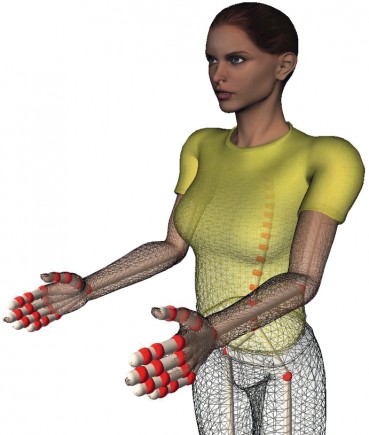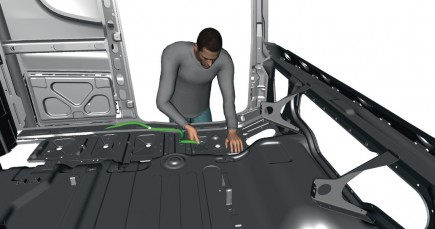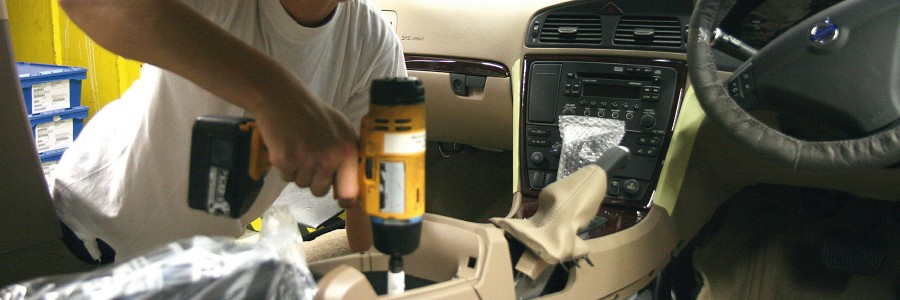Better ergonomics in assembly plants reduce work-related operator injuries, improve quality and productivity, and reduce cost. Motivated by this, new methods, algorithms and software tools have been developed in the IMMA project that enable fast and easy evaluation of assembly ergonomics, while taking into account human diversity. The IMMA project has successfully combined advanced mathematics, ergonomics, and virtual product realization. The project was part of the SSF ProViking Program and involved researchers from FCC, Wingquist Laboratory VINN Excellence Center at Chalmers and Virtual Ergonomic Center, in close collaboration with our industrial partners Volvo Car Corporation, Scania, AB Volvo, and Virtual Manufacturing.

To automatically create manual assembly motions, a detailed modeling of human body kinematics is needed. The biomechanical model of the IMMA manikin is built as a simplified human skeleton and consists of 82 bone segments. The joints in the biomechanical model have in total 162 degrees of freedom to represent the mobility of a human body. Similar to a human, it is possible for the IMMA manikin to perform assembly motions with different positioning of the body. However, not all positions may be preferable due to ergonomics or unwanted contact with objects in the environment. A comfort function is defined to determine which positions of the manikin that are ergonomically sound. The comfort is based on ergonomic criteria of the biomechanical model and has been formalized to fit the mathematical framework of IMMA. In this way, it is possible to automatically rule out the positions that are not seen as comfortable for the manikin when generating assembly motions. It is important that the generated assembly motions are collision free since the assembly operations are made mostly in tight and narrow regions. In the IMMA tool, the manikin automatically avoids both self collision and collision with objects in the environment.
Instruction language
In order for a user to easily perform an assembly simulation, the IMMA manikin can be instructed with a high level instruction language. Inspired by the methods used to instruct human assembly workers, the manikin is instructed with sentences similar to human assembly instructions. This is possible since the whole assembly station is modeled as a discrete event system that utilizes the automatic features of the IMMA manikin.
Anthropometric
The human comes in many different sizes and to simulate this, IMMA offers the possibility to create individual manikins specified by different body measurements. An IMMA manikin is generated out of 56 anatomical variables. However, a user only has to specify the measurements of interest, and all other measurements needed are thereafter estimated based on an anthropometric data set. It is important that the anthropometric difference of a population is considered when designing product and production systems. It is easy to simulate with several manikins in IMMA, called families. A manikin family is
instructed as a single manikin and may consist of manikins of arbitrary size and gender. In this way, an assembly operation is evaluated with a broad range of anthropometric variance. Moreover, different assembly motions may require different families to ensure that the variances with respect to the assembly specific anthropometric variables are covered. To encourage the engineer to use manikin families without being an expert in the field of ergonomics, extensive research has been carried out to find easy to use sample methods. IMMA is a user friendly tool that aids the user in creating families that accommodates the intended population performing assembly operations.
Ergonomic assessment
Two common ergonomic assessment methods used in industry today have been implemented in the IMMA software. The methods are integrated into the biomechanical framework of the IMMA manikin. This integration reduces the time needed for a user to analyze a simulation and allows non-experts to easily pick up and perform quick evaluation of assembly simulations. Since the users that perform the ergonomic evaluation have different background and experience, there is always a risk for non confirming classification of an assembly motion. With assessment methods integrated in the IMMA manikin, the simulations will always achieve the same classification, regardless of the user.

Moreover, since it is possible to evaluate whole assembly motions in IMMA, it is also possible to extract measurements as e.g. joint angles, velocities, and accelerations of the biomechanical skeleton for free. Measurements, which were previously only possible to extract from human workers, are now available in an early stage of the project. Methods are developed based on frequency analysis of simulated motions and correlation analyses with epidemiological data from different professions. This brings us closer to a method for predicting the probability that the studied assembly operation will result in a future injury.



